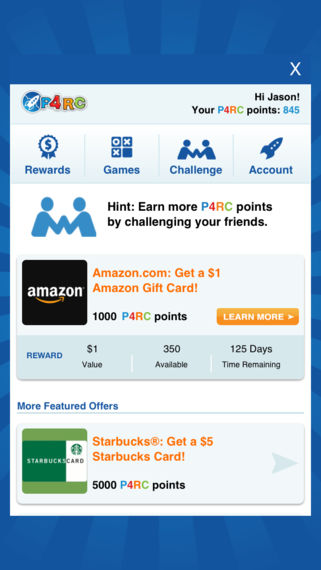
One of the concepts I teach in my integrated marketing communications class is the use of classic positive reinforcement in marketing, which has been recently reclassified as gamification by marketers in the digital era. Foursquare, with its achievement and partner badges, was an early pioneer in this era. More recently, retailers have been "combating showrooming," the phenomenon of consumers visiting a store and comparing prices on mobile devices through apps such as Shopify and Target's Cartwheel, with this technique. Shopify nudges shoppers to earn points by visiting stores more frequently and to explore more of the store once inside its doors. These points eventually lead to real-world rewards, from coffee gift cards to a Vespa Italian scooter. The downside is that consumers have to leave home or roam the city and a store for rewards; thus, the most participants will likely engage infrequently at best.
An interesting concept with higher potential engagement is emerging in mobile gaming (integrating a gamification layer into games). Sound tautological or circular in logic? Not really. A company called P4RC (pronounced park) has launched a concept that combines game playing and rewards from brand partners.
In a nutshell, game developers can include the P4RC functionality to drive engagement with a mobile game and reward extended gameplay. As gamers play and compete with their social networks, they earn points towards branded gift cards with national marquis brands. Unlike with the showrooming apps described above, consumers earn these rewards from P4RC wherever they are and wherever they want to play.
Here are a few reasons why this approach makes sense from a marketing strategy and consumer psychology perspective:
Gaming and Roaming. PewResearchCenter's recent mobile study found that 63 percent of mobile phone users go online with their mobile devices. Consumers today are time-compressed and on-the-go, and mobile devices are deeply engrained in consumers' lives. A glance at the top 10 list of the major mobile platforms app stores demonstrates that consumers are downloading games in significant quantities. Gaming is hot with mobile consumers, and finding ways to tie branded rewards into this already popular activity makes sense. But very few apps actually make it in the competitive app store environment. In fact, Business Insider states that 99 percent of mobile games are unprofitable; positive reinforcement through rewards can be a strategy to drive installs and continue engagement.
Support Freemium. A common model used by game companies today is Freemium; they give the app away, but sell access to additional levels or "weapons" to pass difficult levels. In this model, the developer stimulates a free trial but hopes that the user will enjoy the game enough to spend money to advance past challenging levels. The challenges here are myriad, but the conversion milestones of download and on-going engagement mean that the concept must be very compelling to stand apart. Layer in P4RC's concept of rewarding users for extended participation with branded rewards, and install plus time spent with levels passed can result in real-world branded rewards for the mobile user. Gamers have not only the intrinsic motivation of wanting the achievement of passing a level, but also the potential of earning a tangible reward in the form of a brand gift card. This dual appeal to achievement holds much potential.
Tangible Rewards and Results. To date, P4RC has demonstrated increases in the frequency and duration of mobile gaming sessions (with observed uplift as high as 600 percent) by incentivizing players to increase their gaming duration and make them social with friends.  Developers benefit by layering in incentives for players to engage via initial download and to stick with an app with extended gameplay. With achievable redemption targets that gamers can unlock for rewards from retailers like Amazon, Target and Best Buy, the potential of the service looks encouraging. And these advertisers and brand partners benefit nicely as well; they get an engaged audience at a low cost of acquisition. To date, over $100,000 in rewards have been distributed.
Developers benefit by layering in incentives for players to engage via initial download and to stick with an app with extended gameplay. With achievable redemption targets that gamers can unlock for rewards from retailers like Amazon, Target and Best Buy, the potential of the service looks encouraging. And these advertisers and brand partners benefit nicely as well; they get an engaged audience at a low cost of acquisition. To date, over $100,000 in rewards have been distributed.
As brands are facing the second screen phenomenon (the TV now being the second screen to the mobile device), embedding brand promotion within mobile experiences is a strategy that will expand and mature. While P4RC's concept is in its infancy, it is expanding its OS footprint to Android this month (in addition to its currently available iOS version. As more gamers earn rewards and share with their social networks on games supporting P4RC rewards, I anticipate hearing more buzz on this concept.
